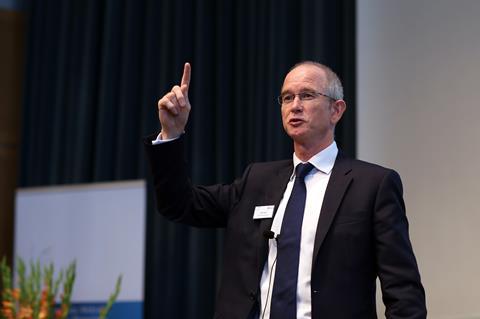Geologist and chief risk officer John Scott flies the flag for mitigation, adaptation and behavioural change in the battle against climate change

Debate around climate change often polarises opinion. There are two schools of thought: those who acknowledge that change is taking place and those who deny this is the case despite what appears to be significant evidence to the contrary. Judgements on both sides are often poorly informed through a lack of understanding, deliberate or otherwise.
For those who seek to determine the truth, acknowledging that climate change cannot be considered in simplistic terms one way or another is perhaps the best starting point. Gaining true insight requires consideration of myriad factors, historic and future, and a deep knowledge of the science behind theoretical perspectives and empirical measurement.
Few are better qualified to do this – or to articulate the risks – than John Scott, chief risk officer at Zurich Global Corporate. Scott’s role necessitates taking a view on the broader risk landscape for Zurich. He is widely respected among his peers and across the industry for his depth of expertise on some of the key challenges facing businesses around the world. Scott was the only individual from any insurance company to be singled out by several respondents for risk management expertise and knowledge in the recent StrategicRISK UK Corporate Insurance Buyers’ Survey.
Demand for his services from Zurich and its clients, as well as his involvement with the World Economic Forum and other associations, mean that although Scott is based in London he is only a transient visitor to his own office.
The suitcase next to a coat stand indicates another imminent international departure – to Zurich’s Swiss headquarters – on the same day as this interview. Before that, however, he is focused on the issue of climate change.
Scott’s academic background – a geology degree from Oxford – and his business experience as a geologist in the oil and gas industry and as a chief risk officer in the insurance industry make him well placed to understand some of the often contradictory factors around climate change and weather, and the potential implications of these from a risk and insurance perspective.
“When you read what’s written about climate change in the insurance industry, it generally falls into a couple of categories,” Scott says. “It is either broad and high-level, with papers written about the potential future impacts of climate change, or it is focused on adaptation, typically taking an underwriting view around minimising the impact of flooding on property risks.”
He has little doubt that human influence “in terms of carbon dioxide emissions” has affected climate change, particularly since the Intergovernmental Panel on Climate Change (IPCC) made that explicit link with the backing of the scientific community.
“Who are we to deny 1,000 scientists agreeing on something when it is hard enough sometimes to get two scientists to agree on anything?” he asks. “We should take it, as a lay community, that the scientific community agrees that there is anthropogenic change [human influence] on the climate.”
The bigger question, he says, surrounds the link between changing climate and extreme weather patterns. There is an increasing body of scientific work on this, known as ‘attribution’. Intuitively, it would seem reasonable that a warming planet would in some way affect weather patterns. The reality is that is it difficult to say whether any one extreme weather event and its consequences are the result of climate change.
In any one flooding event, many factors influence the level of damage – from management of flood defences through to increased concentration of insured assets in coastal cities – and these have a direct correlation with economic growth.
“Since the 1950s, there has been a dramatic increase in urban dwelling, especially in coastal cities,” Scott says.
“So when you see a chart over time showing increasing value of assets destroyed by weather-related natural catastrophes, it is difficult to discern whether this secular trend is related to the increasing frequency and intensity of weather-related natural catastrophes.
“If tracking weather intensity – the strength of winds in a hurricane – and the frequency of hurricanes, then it is a little more difficult to see a discernible pattern over time.”
Short-term climatic influences
Climate change operates over a long period of time and the earth has many mechanisms that influence weather over the short term. The impact of El Niño and La Niña, ocean current circulation and the movement of the jet stream all influence the weather and it is difficult to discern the effect of climate change on weather models.
The sophisticated computing power of modern meteorologists is showing analysis that a climate signal is affecting the increasing effect of severe weather, but the science is not yet conclusive regarding frequency. As a result, the commercially available natural catastrophe models used by the insurance industry for pricing have only weak climate signals in them. To quote one science journalist on the topic of attribution, “the boffins are still baffled”.
“It is clear that the geographic pattern of tropical cyclones is changing,” says Scott. “There has been a period of relatively benign Gulf coast hurricane seasons, but hurricane activity and intensity have increased in the Pacific basin. Some have linked this to movements of the jet stream – which in turn relates to the melting of Arctic ice and has an effect on the upper atmosphere – and the occurrence of hurricanes and other severe weather, such as the recent frosts in North America and last year’s intense depressions across the UK and the western European coastline.”
He acknowledges, however, that the connection with climate change is less straightforward. “It is a very complicated story and it is difficult to make this link, which happens over a very long period, almost outside human observation – over decades if not centuries, if not millennia – to what we notice on a day-to-day, week-to-week basis, which is the weather.”
Scott lends some geological context to the picture. “Considering all the science that enables the understanding of paleoclimates [climates in the past], clearly, the earth has gone through periods where there have been greater concentrations of greenhouse gases, carbon dioxide and water vapour in the atmosphere. This is related to increased periods of volcanicity, which is in turn related to the rate of continental drift and the impacts on ocean current circulation, depending on how continental plates and land masses have been arranged around the earth. Over geological time, these factors have had a major effect on climate and sea level.
“Other factors also affect climate, such as the Milankovitch cycles, which relate to the way the Earth oscillates around on its axis as it goes around the Sun,” adds Scott. “Over a 30,000-year period, that axis wobbles and this can be seen in the geological record as cycles of sea-level change related to changing climate.
“All these factors influence changing climate on Earth and changing weather patterns and that is way before humans ever evolved. Now humans are here and in the past 150 years they have burned a lot of fossil fuel and emitted a lot of carbon [trapped fossil fuels]. That means carbon from coal, oil and gas buried in the deep subsurface has now been released as carbon dioxide into the atmosphere.”
Given that climate change is here for a number of reasons, the challenge for humankind is tackling the problem. The solutions fall into three areas: mitigation, adaptation and behaviour.
Mitigation “has not achieved what was expected or quickly enough”, says Scott. “It is now more than 20 years since the Kyoto Protocol and there has been no globally binding greenhouse gas [GHG] emissions agreement.”
Some countries have developed policies to introduce low carbon power generation and the transportation industries are slowly beginning to address the challenges of GHG emissions. Overall, these two sectors contribute more than two-thirds of GHG emissions globally.
The International Energy Agency and other agencies have encouraged the power generation industry to introduce renewable power (wave, wind, tidal and solar), nuclear power, hydroelectric power and carbon capture and storage of fossil fuel power plants. There are technical challenges in all these technologies related to base load and intermittency, but new technologies such as smart grids and grid-scale storage are being developed to address this.
Transport developments
In the transport industry, gradual changes in engine technology have led to the development of hybrid vehicles, plug-in hybrids, fully electric vehicles and hydrogen fuel cell vehicles. Technical challenges arise with battery technology and developing a low-carbon hydrogen supply chain, not to mention novel risks to manage and mitigate.
The challenge for the insurance industry is to encourage these developments by providing appropriate risk management insights and, in some cases, niche insurance products.
Insurers have a role to play in providing policies to protect emerging risks around low-carbon energy – “especially the property ones”, says Scott.
“There have been some good examples in the wind and the solar energy world, where novel insurance policies have been created in the past 10 years to support those technologies,” he says.
Adaptation is where most people’s focus lies, says Scott. Protecting large urban areas through more secure flood defences and better management of water as a resource, are two examples among many.
However, management of water – be it too much through flooding or too little through drought – is complex. It involves many stakeholders, ranging from landowners and farmers to planners, water companies, government regulators, industrial users and private consumers. This is also an area in which the insurance industry has abundant risk management insight. Insurance experts can provide sound advice to customers and governments on the best approaches to manage flood risk.
If climate change progresses to the point where nations feel they are being economically or environmentally damaged, they may be encouraged unilaterally to use geoengineering to protect their populations, potentially leading to the risk of rogue geoengineering. This is already happening as some nations use techniques such as cloud seeding to encourage and divert rainfall away from flood-prone areas. The consequences can be dramatic for neighbouring nations, which might suffer drought when seasonal rainfall fails or unexpected flooding.
More serious attempts to adapt to climate change may include creating geostationary sunshades in low-orbit space above nations to reduce temperature or injecting microparticles into the atmosphere to create clouds and shade. All of which have unpredictable and potential harmful effects on the climate and environment.
Behavioural change is another important area to manage. Climate change is a global risk to which everyone has contributed over many generations, emitting GHGs as nations since the industrial revolution. “Every time a person gets into a car, every time an electric device is used that requires fossil fuel to be burnt to generate that power, people rarely think about the consequences of their actions.”
The failure of global governance mechanisms to create controls on GHG emissions has encouraged some people to take political or legal approaches to enforce change. In some jurisdictions, attempts have even been made to assign legal liability for climate change to industrial organisations, in particular in the power generation, oil and gas and mining industries. However, despite several court cases, legal action has not been successful and is probably neither an effective nor long-lasting solution to behavioural change.
“Pricing as a mechanism to influence behaviour is important,” says Scott. “It is something that the insurance industry can use to show to the outside world the level of risk associated with an activity by the way that risk is priced.”
Scott concedes that sometimes pricing alone is not sufficient and that regulation or legislation are the only effective way to drive meaningful change.
“If it is against the law to do something – to build a house on a floodplain, for example – then that is a powerful signal,” he says. “People just won’t do that if they face jail or a huge fine.”
Mitigation, adaptation and behavioural change are all important approaches that need to be developed together, not individually, to bring about change.
“It sounds simple to boil it down to three approaches, but of course there are so many different pressures on all the actors that it is very complex,” he says. “If it were that simple, this problem would have been fixed a long time ago.” Mike Jones
Reaching tipping point
The effect of greenhouse gases (GHGs) on climate change is influenced by many factors over time, but one important aspect is the many different ways in which the earth manages the carbon cycle.
There are multiple sinks and stores for carbon, most of which act in a slow, gradual way to exchange GHGs in and out of the atmosphere. However, some carbon stores can release GHGs in a much more sudden way. Scott identifies methane hydrates as one potential trigger for rapid GHG emission and acceleration of climate change.
Methane hydrates form in the sediment of the deep ocean floors when plankton and other marine biomass settle on the sea floor. The decaying process of organic matter produces methane, which becomes trapped in
top layers of sediment in a frozen crystalline form of methane – methane hydrate – because of the cold temperatures on the deep ocean floors. Temperatures
at this depth were once considered to be universally constant but are now known to be rising.
“It would not take much for the ocean floor to warm
up sufficiently for methane hydrates to be released as methane and that is a very different trigger,” Scott says. “The release of methane hydrates would dramatically increase the GHG effect because methane is a much more powerful greenhouse gas agent than carbon dioxide.
“The fear with climate change is not that it is gradual and steady, but that it will trigger one of these mechanisms to release a lot of additional GHGs from some previously unreleased carbon stores. That would have a dramatic effect on climate. This is similar to the disaster movie scenario where a very rapid change in climate would take place, but it is also something that is real. The implications of this would be to make life very difficult for human beings on the planet – not only in certain regions but perhaps everywhere.” It is this scenario of runaway climate change that most concerns climate scientists, not merely the gradual effects of a slowly warming world.
CV
λ
Graduated in geology at Oxford University; also has a PhD in sedimentology from Aberystwyth University
λ
Gained commercial experience in the chemicals industry with BOC
λ
2001: senior vice-president of Zurich Strategic Risk
λ
2007: became Zurich’s head of risk insight
λ
2009: promoted to chief risk officer, Zurich Global Corporate, leading global and local implementation of the enterprise risk management strategy
λ
2010: joined the CCS Development Forum, an industry and government group working to maximise business opportunities to deploy carbon capture and storage in the UK
λ
Chairs the Carbon Capture and Storage Association group on risk and is on the stakeholder dialogue board of the ECO2, an EC project to investigate the effect on marine ecosystems of sub-seabed CO2 storage




















No comments yet